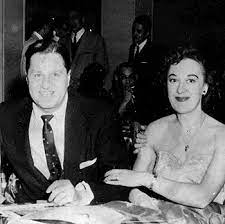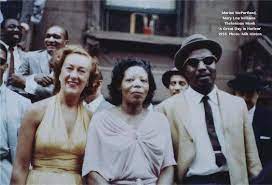Below is the blog entry I posted on Marian McPartland a year ago. Today is her 95th birthday, and as this small world would have it, I sat next to Huey, the producer of the McPartland documentary In Good Time, at a Northampton restaurant on Sunday. Huey told me that he’d had lunch with Marian on Friday at her home on Long Island and that she’s in good health and great spirits. Tune in for an hour of her music in tonight’s Jazz a la Mode where we’ll hear her playing Ellington, Benny Carter, and Mary Lou Williams.

Duke Ellington’s greatest asset may have been his skill as a listener. He famously recruited a wide array of musicians and coaxed from them the individual sounds that he prized as theirs alone, then stylized them to his own ends as a composer and bandleader. Ellingtonians were as tight-lipped as the Maestro about his methods, so we know very little about what Duke actually said to inspire Johnny Hodges and Lawrence Brown and Paul Gonsalves. But it’s long been known that he offered Marian McPartland an incisive appraisal of her piano playing when he first heard her in the early ‘50’s at the Hickory House, Ellington’s favorite New York steakhouse. “My, you play so many notes,” was Duke’s brief assessment, and as McPartland acknowledges in the documentary In Good Time: The Piano Jazz of Marian McPartland, he was right.
To the pianist’s credit, she took Ellington’s “charming” advice and developed a manner of keyboard playing that takes its time and breathes in all the right places. The same can be said for the film that producer/director Huey has created about the 94-year-old native of Windsor, England. The documentary runs eighty-six minutes, which gives it enough time to convey something of the sweep of McPartland’s life from her girlhood in a “conservative, upper-middle-class” home to her decade-long engagement at the Hickory and the 33 years she spent as host of NPR’s Piano Jazz. As Huey explained last night at Amherst Cinema, much of the film was shot during production segments of Piano Jazz, so the sound is exceptionally clear and resonant.
McPartland was a child prodigy, but she met strong parental objections over her interest in a career in music. In the face of her mother’s charge that she was “pigheaded” and other “harassments” that took McPartland years to “grow out of,” she persevered, first playing the English Music Hall circuit, then with the outbreak of World War II, she volunteered for ENSA, the English equivalent of the USO. By 1944, as she told Whitney Balliett for his New Yorker profile of her, “The Key of D Is Daffodil Yellow,” she “switched to the USO which paid better and which meant working with the Americans! Boy, the Americans!”

One of “the Americans!” was trumpeter Jimmy McPartland, a Chicago-bred live wire who succeeded Bix Beiderbecke in the Wolverine Orchestra in 1927, and went on to a long career playing traditional jazz at Eddie Condon’s and the Metropole in New York. (Replacing Bix, perhaps the most prestigious job for a white jazz trumpeter in the ‘20’s, isn’t mentioned in the film, but we do learn that Jimmy listened to his own recording Shades of Bix on his deathbed.) Snapshots and home movies give vivid evidence of the outsized McPartland wooing the introverted Margaret Marian Turner as they played for the troops in Belgium and France. As Jimmy told Balliett, “She tried to act real GI, but I could see she was a fine, well-bred person and not a juvenile delinquent like me.” After a whirlwind six-week courtship, they married just back of the front lines with no way of notifying her family of the wedding, but once she brought him home, McPartland charmed her parents by making her mother laugh and taking her father to the movies.
Moving to Chicago after the war, Marian followed Jimmy for several years from gig to gig and bender to bender before she made her own way to New York in the early ‘50’s and became established with her trio, a group that coalesced around bassist Bill Crow and drummer Joe Morello. Still, the family back home remained disapproving, and she told Balliett that her benighted maternal uncle, Sir Cyril, “came over when I was working at the Hickory House and [was] shocked and mystified by the whole scene. Uncle Cyril took me aside between sets at the club and said, ‘Does your father know what you’re doing’?”
Little of these dilemmas, whether familial or marital, is explored in Huey’s documentary. There are slight hints, but it’s nearly over before viewers learn that the McPartland’s divorced in the ‘60’s, and it’s in Balliett’s profile where we learn that Marian spent six years seeing a psychiatrist who “indirectly precipitated a lot of things.” The end of the marriage apparently motivated Jimmy to quit drinking, and spurred Marian to become “twice as productive.” Eventually they came back together again as the best of friends, for as Jimmy put it, “the divorce was a failure.”

Whatever In Good Times fails to convey of the stormier elements of Marian’s life, it makes up for with her music, her stiff-upper-lip spunk, and the testimonials of numerous eloquent and sympathetic musicians, most of which carry powerfully affecting assertions about McPartland’s character and achievements. Chief among these is vocalist Nnenna Freelon, who says that while she’s sure Marian survived many undisclosed hard knocks as a female musician, she’s a model of a woman who, “like a river,” flows around obstacles and keeps on moving. Freelon is also seen with McPartland at Tanglewood performing an “Amazing Grace” that’s as moving as any I’ve heard. Its placement in the film, like that of most of the extensive music clips, is perfectly timed.
Jeremy Pelt hails McPartland as one of the living masters whom young musicians need to know; Renee Rosnes elicits a few wisecracks from the lady, who notwithstanding her background and present status as a member of the Order of the British Empire, is capable of swearing like a “docker.” Diana Krall tells a sweet story about phoning Marian out of the blue when she was an unknown in her teens, and getting a return call. The only miscast participant is Krall’s husband Elvis Costello, who carries on a lively conversation with his fellow British subject, but who betrays the standards of jazz with a terribly off-pitch, over-dramatized effort at singing “Our Love Is Here to Stay.” He should really stick to “Watching the Detectives.” His presence here and in other jazz settings like the Mingus Orchestra leaves me with an unsettling feeling that jazz is desperate for whatever sense of validation pop stars like Costello might confer on it. He must add luster to the marketing of a film like this, but his singing should have been left on the cutting room floor. (Lest you think I’m a jazz snob, let me assure you that I’ve shelled out long green to see Costello in concert, and number “(What’s So Funny ‘Bout) Peace, Love and Understanding” among my favorite rock tunes.)

Anyone familiar with Piano Jazz knows how truly gifted McPartland is as an improviser. But seeing her on camera with Dave Brubeck, Mulgrew Miller, Rosnes, and school kids galore adds a new level of appreciation to this aspect of her art. Perhaps it was her outsider status as an Englishwoman striving for mastery of the American idiom that made her a quick study of other players, but her skill at distilling the essence of another’s style and creating a spontaneous piece that captures them so fully strikes me as an aspect of genius. I’d never felt quite so profoundly appreciative of Marian until I saw In Good Time, and I trust you will too.
(In Good Time: The Piano Jazz of Marian McPartland was given its area premiere last March in the series that New England Public Radio, the UMass Fine Arts Center, and Amherst Cinema is presenting. Next up in the series is a new documentary on drumming legend Chick Webb, The Savoy King. It will be screened on April 1.Tickets are available here.)